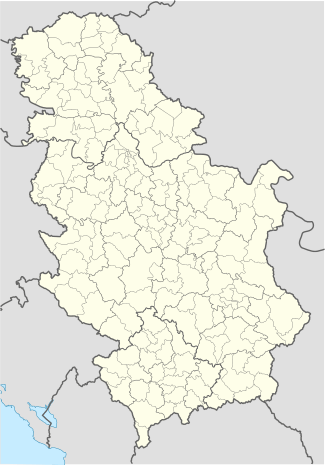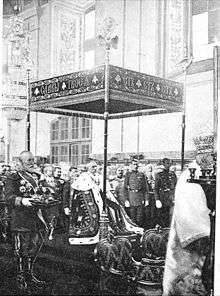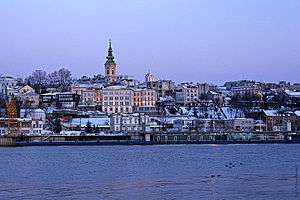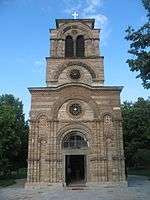St. Michael's Cathedral, Belgrade
| Cathedral Church of St. Michael the Archangel | |
|---|---|
| Саборна Црква Св. Архангела Михаила | |
|
Saborna Crkva | |
 Cathedral Church of St. Michael the Archangel Shown within Serbia | |
| 44°49′5″N 20°27′7″E / 44.81806°N 20.45194°E | |
| Location | Belgrade |
| Country |
|
| Denomination | Eastern Orthodoxy |
| Website | Saborna Crkva Official website |
| History | |
| Founded | 1837 |
| Founder(s) | House of Obrenović |
| Dedication | St. Michael the Archangel |
| Relics held |
King Uroš III Despot Stefan Štiljanović Prince Miloš I Prince Mihailo Prince Milan |
| Architecture | |
| Status | Church |
| Functional status | Active |
| Heritage designation | Monument of Culture of Exceptional Importance |
| Designated | 1979 |
| Architect(s) | Adam Friedrich Kwerfeld |
| Style | Neoclassicism with late baroque elements |
| Completed | 1840 |
| Specifications | |
| Number of domes | 1 |
The Cathedral Church of St. Michael the Archangel (Serbian: Саборна Црква Св. Архангела Михаила, Saborna Crkva Sv. Arhangela Mihaila) is a Serbian Orthodox Christian church in the centre of Belgrade, Serbia, situated in the old part of the city, at intersection of Kralja Petra and Kneza Sime Markovica Streets. There was an older church, dedicated to St. Arch. It is one of the most important places of worship in the country. It is commonly known as just Saborna crkva (The Cathedral) among the city residents. The Cathedral has been proclaimed as the 1st category cultural property in 1979.
The Cathedral Church in Belgrade with its architecture, art work and rich treasury is an impressive cultural monument. It is an invaluable historical monument of the Serbian sector of Belgrade from in first half of the 19th Century, which formed in area around the Cathedral Church, thus becoming its religious, administrative and cultural centre. During the times when new social and political structures were slowly emerging, the Cathedral Church became a central support in the independence fight from Turkish centralism to the final freedom from Ottoman rule.
History
There was an older church, dedicated to St. Archangel Michael, at the site of today’s church. Protestant priest and a writer on travel Stjepan Gerlach gives us precious records of its looks in descriptions of travels of Emperor’s delegates to Istanbul, 1573-1578. Although spacious with all necessary liturgical accessories and furniture it was not large enough to receive all the Christian citizens of town of Belgrade.

Later records of existence of this church[1] were mainly saved by writers on travel from the 17th and the 18th century, who inform us broadly about its destiny. During Turkish-Austrian conflicts in the beginning of the 18th century it was destroyed, and the Austrian authorities were explicit in their order not to restore the damaged Serbian temples, former Metropolitan Mojsije Petrovic, who had expected the support of Russian Czar Peter The Great, who had meanwhile died, started renewal of the Church from its foundations, decorating it with a new iconostas. Unfortunately, serious historical circumstances once again affected the life of the Church resulting in this being not the only restoration.
In the Treaty of Belgrade concluded in 1739 Turks got along with other once again Belgrade and "as soon as they entered the town they showed their anger toward Serbs and Serbian relics on this occasion".[2] Impressive Residence of Serbian Metropolitan was torn down, and the church "rubbed and its roof torn down".[2] Few decades later, at the beginning of 1798 the church once again suffered from damage, this time in fire. Repaired for services it served until the beginning of 1813, when after breaking of the First Serbian Uprising Turks desecrated and robbed it. Necessary restoration work was performed after the Second Serbian Uprising.
Proclamation of Hatiserif in 1830, on the day of St. Andrew, according to which Serbia got the freedom to perform the religious service, and by the order of Prince Milos "beside the old church, a wooden bell tower was built ",[3] in which the bells were put.
For the purpose of casting a great fi re was lit, which burned for three days. People would pass by and throw diff erent silver objects to mould with bronze that was melting, so bells would have "a more silvery" sound. Former Belgrade citizens were waiting for this happening "as for something great and unreachable. For them the sound of bells did not represent just an ordinary religious custom. The bells represented a symbol of centuries expected victory".[4] Decision brought by Prince Milos was accepted among Turks with doubt and threat. An anecdote was saved until present days about a threat of Belgrade’s vizier Husein – Pasha Gavanoz Oglu (1827-1833 ) referring to Duke Petar Cukic, who was in charge of construction of the bells, that he shall be punished for that. The brave Duke replied: "I know, I know Efendi Pasha, if I raise them I shall die of Turkish hand, and if I do not, I shall die of hand of my master Prince Milos. I prefer to die of the Turkish hand then from hand of my master, as his disobedient servant.".[5]
Today, the bell of the old Cathedral Church is situated in the bell tower of the Church of Ascension (1863) with its five bells different in size and origin. This bell sounded for the fi rst time on 15 February 1830 when Serbian Princedom got its autonomy. Destroyed and repaired the old church had struggled with evil times until 22 June 1836, when, after numerous discussions Prince Milos Obrenovic ordered the church to be torn down and a new one constructed. Construction of the new Cathedral Church had begun on 28 April 1837. Consecration of its foundations on 15 July 1837, of the "Cathedral Church of Belgrade",[6] a contemporary described as an exceptional happening, witnessed by Metropolitan Petar Jovanovic, Church dignitaries of high rank, Princess Ljubica and successors Milan and Mihailo, serfs, children and "folk of both sexes".[6] The cannons were roaring and people were saying "church blessing this happy and happier time".[6] On the day of Patron’s Feast Day of the Church, St. Archangel Michael, on 8 November 1845, Metropolitan Petar Jovanovic has consecrated the fi nished Church and served the first liturgy in it.

Although the author of the design remained controversial for a long time, it is certain that the Church was built by constructors from Pancevo, according to project made by Fridrih Adam Kverfild.
The cathedral was built from 1837-40. The gold-plated carved iconostasis was made by the sculptor Dimitrije Petrović, while the icons on the iconostasis, thrones, choirs and pulpits, as well as those on the walls and arches were painted by Dimitrije Avramović, one of the most distinguished Serbian painters of the 19th century.
The special value of the church is its treasury. The relics of Serbian saints emperor Uroš V and despot Stefan Štiljanović, as well as the heads of the Church and Serbian rulers of the Obrenović dynasty (Miloš, Mihailo and Milan).
The Cathedral Church was one of the biggest religious buildings in Serbian Princedom and after the Church of St. Peter and Paul in Topcider (1832/34) the oldest one on Belgrade.
The Church has a single nave construction with semi-circular apse on the East side and narthex on the West side above which the high bell tower is rising. The inner space is divided to alter part, nave and narthex in which baptistery and stairs leading to bell tower are situated. Diff erent from the North and South façade, shaped simply and in the same manner, the West façade is emphasized by distinct portal and wide entrance stairs. Architecture of the Cathedral Church directly adopted with its assembly and fi ne proportions the standards of neoclassical churches with recognizable baroque tower, that were built at the same time in Austria. Somewhat older Cathedral Church in Sremski Karlovci (1758), which also belongs to this group, could have been a possible model. Architecture of this church was very used as a model in sacral architecture during the reign of Milos.
Decoration and interior works were performed after fi nishing of the construction. Belgrade’s church municipality hired a sculptor, engraver and smelter, Dimitrije Petrovic (1799-1852), educated on Academy in Vienna to make drawings for iconostas and choir.Exuberant in form with certain eclectic decorative elements, iconostas of the Cathedral Church in Belgrade is certainly the most prestigious classicist iconostas in Serbia.
Painting of the Cathedral Church was confided to one of the most famous 19th century Serbian painters Dimitrije Avramovic (1815- 1855), who painted eighteen big wall compositions and almost fifty icons for iconostas during the period of 1841 to 1845. The Artist was under the infl uenced of the historical school of Vienna and German Nazarenes, but his distinct feeling for a dramatic colour scheme and plastic-dramatic rhythm created a recognizable Serbian manner.He has created unique monumental compositions of religious content at the walls of the Cathedral Church, highly evaluated in newer Serbian painting.
Besides painting, engraving works on iconostas, choir and pulpit, wall paintings, a treasury presents a special value, where applied art objects are kept – golden products from the 18th and 19th century, priest’s garments, crosses, individual icons from second half of the 19th century and other objects of cultural historical importance.
In the vicinity of the Church, more precise at a place of today's Zadarska Street and part of Kralja Petra Street and Kosancicev venac an old Serbian graveyard was situated. Its gradual broadening included the church yard of the Cathedral, which was not fenced during the fi rst decades of the 19th century and it served as a graveyard, where prominent Serbian persons of those times were buried.
The skull of Duke Karadjordje, was buried in the south part of the Church yard until 1837, when it was, according to wish and order of Princess Ljubica taken out and transferred to Topola. The relics of St. Czar Uros and St. Despot Stevan Siljanovic (†1540), tombs of Serbian rulers Prince Milos (1780-1860) and Mihailo Obrenovic (1823-1868), as well as the tombs of certain Church dignitaries are situated in the Church. Serbian writer and educator Dositej Obradovic (1742-1811) and reformer of Serbian language Vuk Karadzic (1787-1864) have been buried in front of the main entrance of the Church.
The First Belgrade Singers Society – performing Serbian sacred music, which is active today as well, was founded in 1853 at the Cathedral Church. This choir has been conducted by all distinguished composers of Serbian music, like Josif Marinkovic, Stevan Mokranjac, Kornelije Stankovic and others.
Patriarchate of the Serbian Orthodox Church

Today's building of the Patriarchate was built from 1934 until 1935 and designed by architect Viktor Lukomski. It is located across Saborna Crkva. The building has a square base, it is solid and has monumental forms. On the main facade, against the Cathedral Church, an impressive portico stands out, with low columns and an arched portal above which is a sculpted coat of arms of the Serbian Patriarchate. On the top of this facade, in a niche, is a mosaic composition representing St. John the Baptist. In the east part of the building, there is a chapel dedicated to St. Simeon. It contains a carved iconostasis, the work of Ohrid masters, bearing icons painted in 1935 by Vladimir Predojević. Cathedral Church of St. Michael the Archangel was declared Monument of Culture of Exceptional Importance in 1979, and it is protected by Republic of Serbia. The Library and Museum of Serbian Orthodox Church are in this building, too.
Attraction
The cathedral is a popular tourist attraction in Belgrade; however, for tourists, it is best to visit the church during weekdays as the church usually holds weddings, baptisms etc. during the weekend.
See also
| Wikimedia Commons has media related to Belgrade Cathedral Church. |
References
- ↑ Beside the Cathedral Church dedicated to Saint Archangel Michaeal, some sources (as Spomenica Saborne crkve u Beogradu), about existence of one more Church in former Belgrade, that was dedicated to Saint Jovan the Baptist, but without any closer records.
- 1 2 Joakim Vujic, Putesestvije po Srbiji, I knjiga, 1828. godina, Beograd, 1901, 23.
- ↑ Nikola Nestorovic, Gradjevine i arhitekti u Begradu proslog stoleca, Beograd, 1937, 22.
- ↑ Spomenica Saborne crkve u Beogradu, 41.
- ↑ Dragan J. Rankovic, Iz Beogradske proslosti, BON, 1938. br. 3, 210
- 1 2 3 Мilan Dj. Milicevic, Uspomene, 1831-1855, Beograd, 1952, 61.
Sources
- Бранко Вујовић (September 1996). "Саборна црква у Београду". Belgrade: Projekat Rastko.


